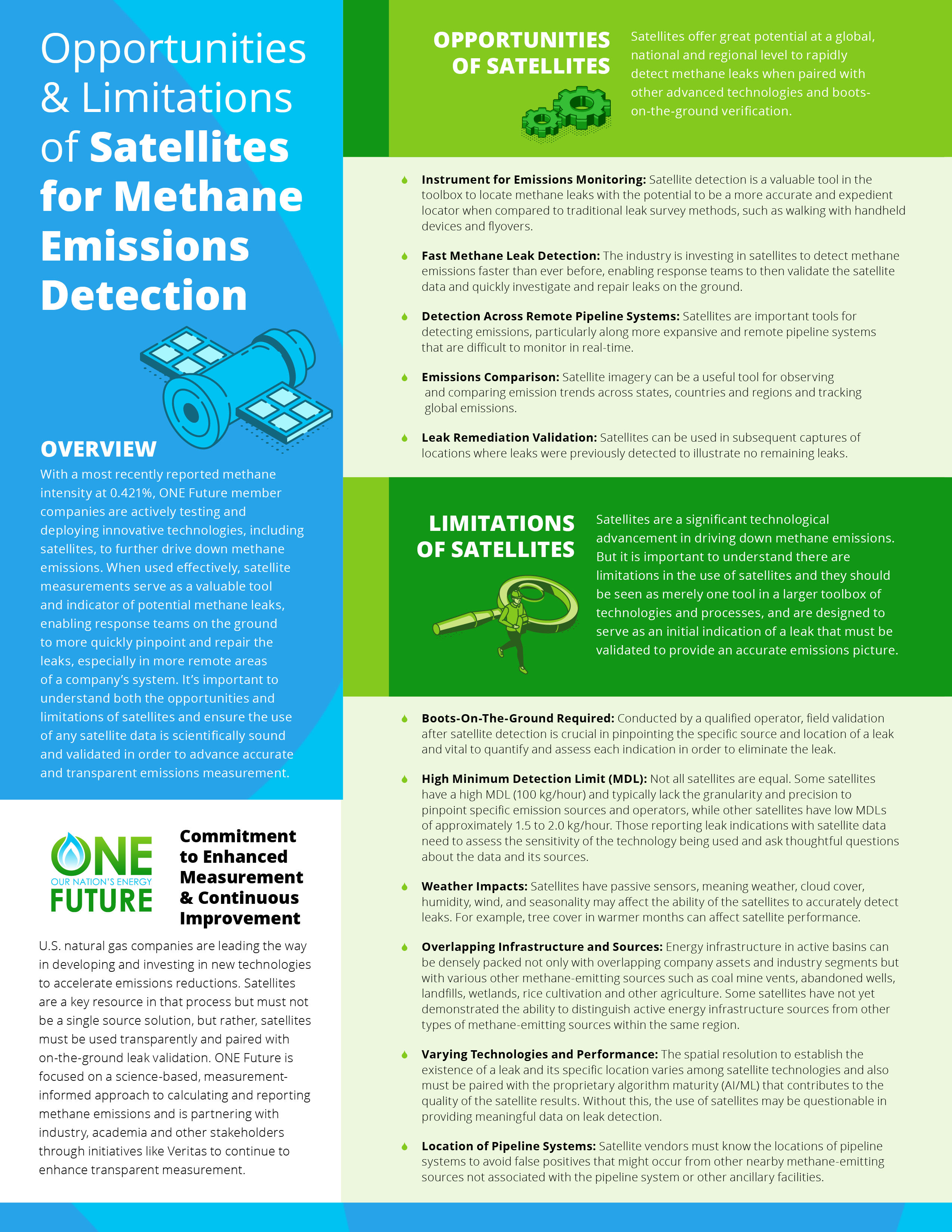Opportunities and Limitations of Satellites for Methane Emissions Detection
Opportunities and Limitations of Satellites for Methane Emissions Detection
Overview
With a most recently reported methane intensity at 0.421%, ONE Future member companies are actively testing and deploying innovative technologies, including satellites, to further drive down methane emissions. When used effectively, satellite measurements serve as a valuable tool and indicator of potential methane leaks, enabling response teams on the ground to more quickly pinpoint and repair the leaks, especially in more remote areas of a company’s system. It’s important to understand both the opportunities and limitations of satellites and ensure the use of any satellite data is scientifically sound and validated in order to advance accurate and transparent emissions measurement.
Opportunities of Satellites
Satellites offer great potential at a global, national and regional level to rapidly detect methane leaks when paired with other advanced technologies and boots- on-the-ground verification.
- Instrument for Emissions Monitoring: Satellite detection is a valuable tool in the toolbox to locate methane leaks with the potential to be a more accurate and expedient locator when compared to traditional leak survey methods, such as walking with handheld devices and flyovers.
- Fast Methane Leak Detection: The industry is investing in satellites to detect methane emissions faster than ever before, enabling response teams to then validate the satellite data and quickly investigate and repair leaks on the ground.
- Detection Across Remote Pipeline Systems: Satellites are important tools for detecting emissions, particularly along more expansive and remote pipeline systems that are difficult to monitor in real-time.
- Emissions Comparison: Satellite imagery can be a useful tool for observing
and comparing emission trends across states, countries and regions and tracking global emissions. - Leak Remediation Validation: Satellites can be used in subsequent captures of locations where leaks were previously detected to illustrate no remaining leaks.
Limitations of Satellites
Satellites are a significant technological advancement in driving down methane emissions. But it is important to understand there are limitations in the use of satellites and they should be seen as merely one tool in a larger toolbox of technologies and processes, and are designed to serve as an initial indication of a leak that must be validated to provide an accurate emissions picture.
- Boots-On-The-Ground Required: Conducted by a qualified operator, field validation after satellite detection is crucial in pinpointing the specific source and location of a leak and vital to quantify and assess each indication in order to eliminate the leak.
- High Minimum Detection Limit (MDL): Not all satellites are equal. Some satellites have a high MDL (100 kg/hour) and typically lack the granularity and precision to pinpoint specific emission sources and operators, while other satellites have low MDLs of approximately 1.5 to 2.0 kg/hour. Those reporting leak indications with satellite data need to assess the sensitivity of the technology being used and ask thoughtful questions about the data and its sources.
- Weather Impacts: Satellites have passive sensors, meaning weather, cloud cover, humidity, wind, and seasonality may affect the ability of the satellites to accurately detect leaks. For example, tree cover in warmer months can affect satellite performance.
- Overlapping Infrastructure and Sources: Energy infrastructure in active basins can be densely packed not only with overlapping company assets and industry segments but with various other methane-emitting sources such as coal mine vents, abandoned wells, landfills, wetlands, rice cultivation and other agriculture. Some satellites have not yet demonstrated the ability to distinguish active energy infrastructure sources from other types of methane-emitting sources within the same region.
- Varying Technologies and Performance: The spatial resolution to establish the existence of a leak and its specific location varies among satellite technologies and also must be paired with the proprietary algorithm maturity (AI/ML) that contributes to the quality of the satellite results. Without this, the use of satellites may be questionable in providing meaningful data on leak detection.
- Location of Pipeline Systems: Satellite vendors must know the locations of pipeline systems to avoid false positives that might occur from other nearby methane-emitting sources not associated with the pipeline system or other ancillary facilities.
ONE Future’s Commitment to Enhance Measurement & Continuous Improvement
U.S. natural gas companies are leading the way in developing and investing in new technologies to accelerate emissions reductions. Satellites are a key resource in that process but must not be a single source solution, but rather, satellites must be used transparently and paired with on-the-ground leak validation. ONE Future is focused on a science-based, measurement- informed approach to calculating and reporting methane emissions and is partnering with industry, academia and other stakeholders through initiatives like Veritas to continue to enhance transparent measurement.

